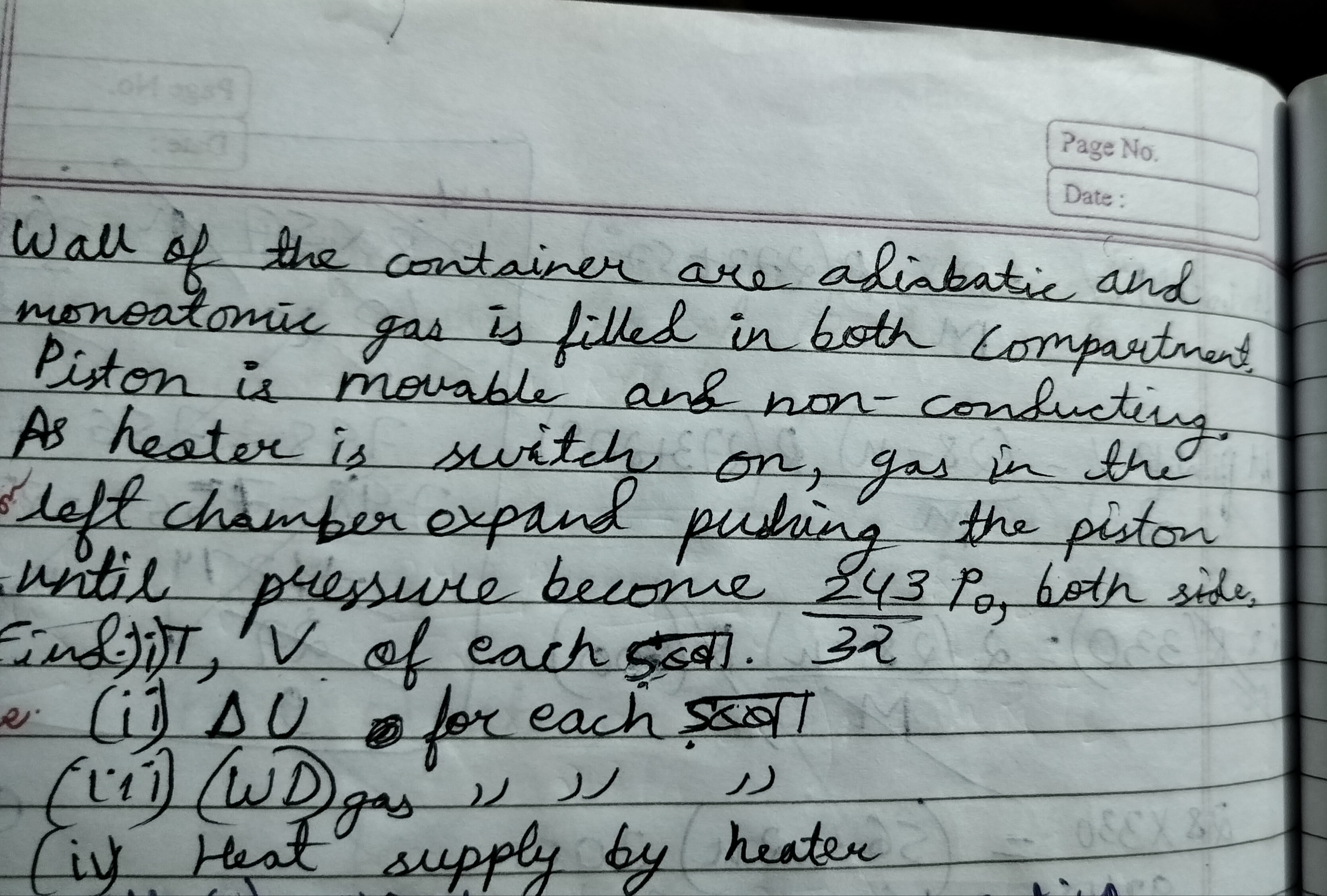Question
Question: Wall of the container are adiabatic and monatomic gas is filled in both compartment. Piston is movab...
Wall of the container are adiabatic and monatomic gas is filled in both compartment. Piston is movable and non-conducting. As heater is switch on, gas in the left chamber expand pushing the piston until pressure become 32243P0, both side, Find i)T, V of each इब्बा. e. (i) ΔU for each इब्बा (iii) (WD)gas ,, ,, (iv) Heat supply by heater

i) Left: VfL=2746V0, TfL=16207T0; Right: VfR=278V0, TfR=49T0 ii) Left: ΔUL=32573P0V0; Right: ΔUR=815P0V0 iii) WL=1−k16191P0V0, where k=ln(27/46)ln(243/32) iv) QL=32573P0V0+1−k16191P0V0
Solution
The problem involves a thermodynamic process in a container divided by a movable, non-conducting piston. The walls of the container are adiabatic. Both compartments are filled with a monatomic gas. Heat is supplied to the left compartment, causing it to expand and push the piston until equilibrium is reached at a final pressure Pf=32243P0.
Assumptions:
- Both compartments contain the same number of moles of monatomic gas, n.
- The initial state of both compartments is P0L=P0R=P0, V0L=V0R=V0, and T0L=T0R=T0.
- For a monatomic gas, the adiabatic index is γ=CvCp=35.
Analysis of the Right Compartment (R): The right compartment is sealed by adiabatic walls and a non-conducting piston, so the process is adiabatic (QR=0). Initial state: P0R=P0, V0R=V0, T0R=T0. Final state: PfR=Pf=32243P0, VfR, TfR.
For an adiabatic process, PVγ=constant. P0V05/3=32243P0VfR5/3 VfR5/3=24332V05/3=(3525)3/5V05/3=(32)3V05/3 VfR=278V0.
For an adiabatic process, TP(1−γ)/γ=constant. T0P0(1−5/3)/(5/3)=TfRPf(1−5/3)/(5/3) T0P0−2/5=TfR(32243P0)−2/5 TfR=T0(32243)2/5=T0(2535)2/5=T0(23)2=49T0.
Analysis of the Left Compartment (L): Heat is supplied to the left compartment (QL>0). The gas expands, doing work (WL>0). Initial state: P0L=P0, V0L=V0, T0L=T0. Final state: PfL=Pf=32243P0, VfL, TfL.
Assuming the total volume of the container is conserved: VfL+VfR=V0L+V0R=2V0. VfL=2V0−VfR=2V0−278V0=2746V0.
Using the ideal gas law (PV=nRT): TfL=nRPfLVfL=P0V0/T0(32243P0)(2746V0)=32243×2746×T0=329×46T0=16207T0.
i) T, V of each compartment:
- Left Compartment (L): VfL=2746V0, TfL=16207T0
- Right Compartment (R): VfR=278V0, TfR=49T0
ii) ΔU for each compartment: For a monatomic gas, ΔU=nCvΔT=n23R(Tf−Ti).
- Left Compartment (L): ΔUL=n23R(16207T0−T0)=n23R(16191)T0=32573nRT0=32573P0V0.
- Right Compartment (R): ΔUR=n23R(49T0−T0)=n23R(45)T0=815nRT0=815P0V0.
iii) (WD)gas (Work done by the gas in the left chamber): The process in the left chamber is a polytropic process PLVLk=constant. P0V0k=PfVfLk⟹P0Pf=(VfLV0)k⟹32243=(4627)k. k=ln(27/46)ln(243/32). The work done is WL=1−kPfLVfL−P0LV0L. PfLVfL=nRTfL=16207nRT0=16207P0V0. WL=1−k16207P0V0−P0V0=1−k16191P0V0.
iv) Heat supply by heater: Using the First Law of Thermodynamics for the left chamber: QL=ΔUL+WL. QL=32573P0V0+1−k16191P0V0.
